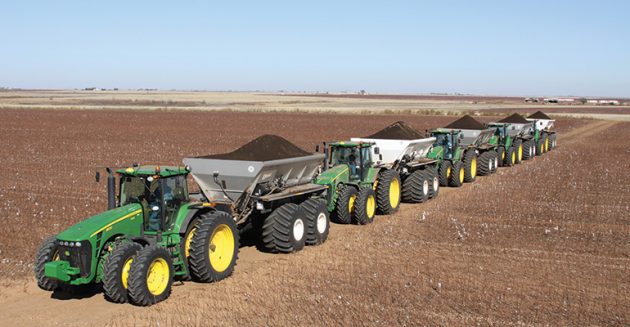
News
Sponsored Content
Boosting the bottom line
How using a high-powered compost/litter spreader can help farmers and custom applicators maximize their productivity — and their profits.
June 18, 2020 by Sponsored by New Leader
As farming becomes more expensive, there’s more pressure on producers these days to increase productivity, maximize efficiencies and get the most out their ag investments.
They’re also expected to do more with less, and a good example of that is how the windows for manure, compost and litter applications are continuing to shrink. Much of that has to do weather. Just ask Mickey Howard, a custom compost/litter applicator who’s been servicing farmers’ fields in Calhoun, KY, for more than 30 years.
As in many other areas, changing weather conditions where Howard lives have led to longer winters and shorter springs in recent years. As a result, there’s much less time for compost and litter applications than there used to be.
“With the weather now, it seems like we do not have the season like we used to. So we’re having to get everything done in about half the time that we had before,” he says.
John Rathjen is director of product development for New Leader Manufacturing, an Iowa-based company that builds crop nutrient applicators for spreading compost, litter, fertilizer and lime.
He agrees that shifting weather patterns have contributed to tighter application windows, not just in Howard’s neck of the woods, but also in other states where compost or litter can’t be spread until the ground thaws.
Rathjen points to changing government regulations as another contributing factor.
“In some places, all the composting material has to be applied before the farmer gets out to the fields because of government regulations, which really reduces the application window,” he says.
Diminishing application windows mean it’s more important than ever for farmers and custom applicators to choose a high-performance compost/litter spreader that maximizes productivity and profitability.
If a spreader has limited horsepower and hydraulic capabilities, the spinner that distributes the compost or litter won’t be able to maintain its speed if there’s too much material flow.
That can lead to poor spread patterns and streaking fields, and to avoid that, the spreader operator has to slow down and reduce the machine’s swath width, which in turn, will dramatically limit productivity.
Spreaders with higher horsepower and hydraulic flow capabilities can apply compost and litter faster, wider, and at higher rates, all while maintaining consistent spread patterns. By increasing their spreadable acres per day, farmers and custom applicators can save time and, by reducing their expenses for fuel and labor, achieve a better cost per acre as well.
Rathjen maintains New Leader’s line of high-horsepower compost/litter applicators are a good fit for those looking to boost their bottom line.
 “That’s what farmers and custom applicators want — to be able to get more done in a day, which increases their return on their investment and their profits,” he says.
“That’s what farmers and custom applicators want — to be able to get more done in a day, which increases their return on their investment and their profits,” he says.
New Leader spreaders include the NL5034, a high-output, high-capacity truck-mounted applicator that’s capable of spreading up to three tons of chicken litter, 60 feet wide, at 12 mph, and the NL600, a pull-type version of the NL5034 that is being introduced to the market this year.
Rathjen says both are built to ensure the uniform distribution patterns that farmers need to get their crops off to a good start and increase their chances of high yields come harvesttime.
Thomas Brittle sells New Leader compost/litter applicators at Southeast Ag Equipment in Wilson, NC, where he is general manager and head of sales.
He describes New Leader’s compost/litter applicators as superior machines that, thanks to their innovative design, can do the do the work of up to two or three other spreaders.
“The spreaders have larger spinner motors and dishes and more hydraulic flow going to them, so they just do a really good job spreading the material evenly on the ground,” he adds.
Brittle notes that the NL600 has a larger, 21-foot long box that requires fewer trips to fill it up.
“Because of the increased capacity, you can spend more time in the field spreading and the more acres you can cover per day,” he says.
Howard, who managed a retail fertilizer store and did custom applications on the side for many years, says he made sure to do his homework when he became a full-time applicator in 1999. He purchased four NL5034s and considers it a great business decision.
“I’m interested in something that does a quality job and is going to be durable and last a long time,” he says.